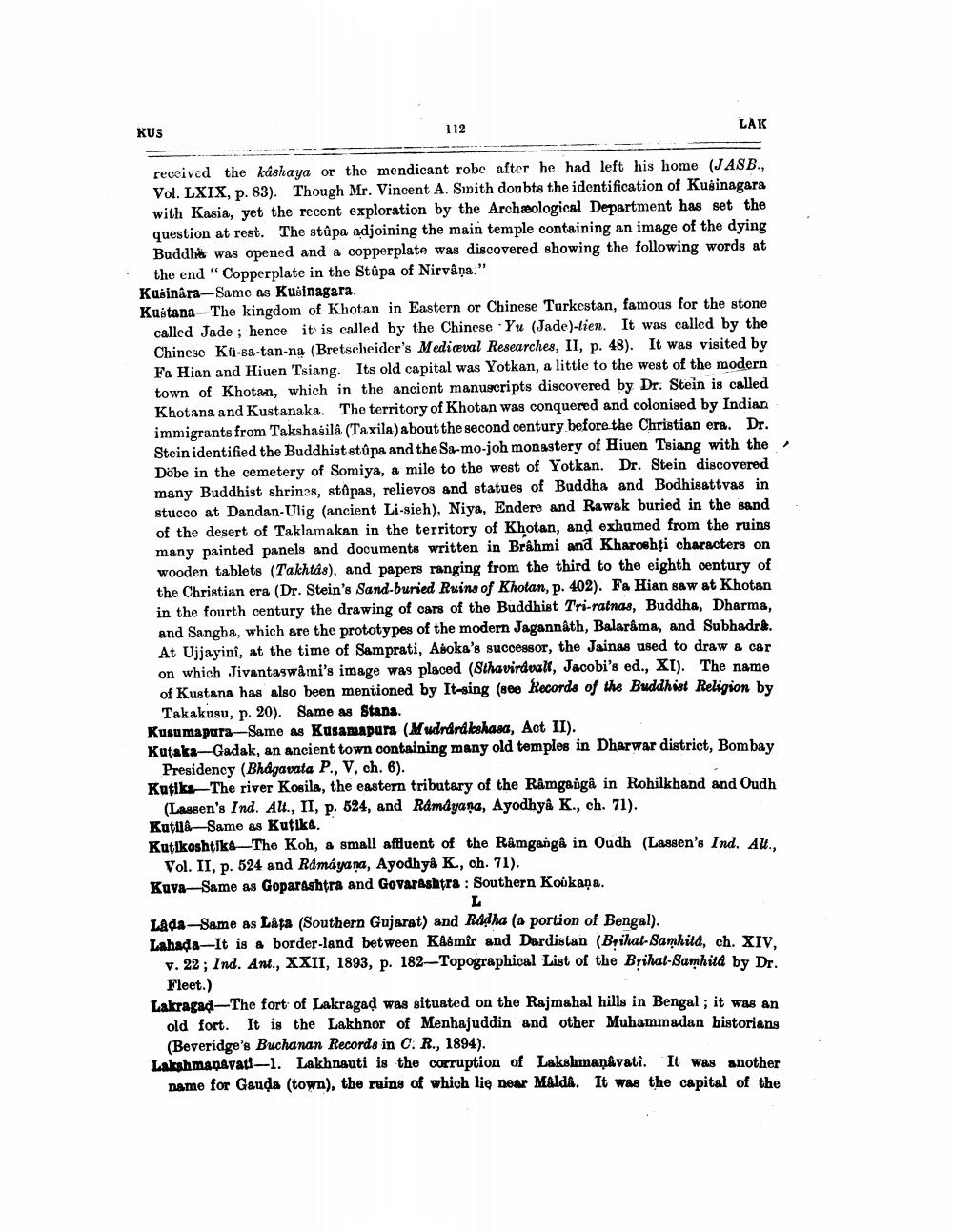________________
KUS
112
LAK
received the kashaya or the mendicant robe after he had left his home (JASB., Vol. LXIX, p. 83). Though Mr. Vincent A. Smith doubts the identification of Kusinagara with Kasia, yet the recent exploration by the Archæological Department has set the question at rest. The stapa adjoining the main temple containing an image of the dying Buddha was opened and a copperplate was discovered showing the following words at
the end "Copperplate in the Stupa of Nirvana." Kusinara-Same as Kusinagara. Kustana-The kingdom of Khotan in Eastern or Chinese Turkestan, famous for the stone
called Jade; hence it is called by the Chinese Yu (Jade)-lien. It was called by the Chinese Ka-sa-tan-na (Bretscheider's Mediaval Researches, II, p. 48). It was visited by Fa Hian and Hiuen Tsiang. Its old capital was Yotkan, a little to the west of the modern town of Khotan, which in the ancient manuscripts discovered by Dr. Stein is called Khotana and Kustanaka. The territory of Khotan was conquered and colonised by Indian immigrants from Takshasila (Taxila) about the second century before the Christian era. Dr. Stein identified the Buddhist stúpa and the Sa-mo-joh monastery of Hiuen Tsiang with the Döbe in the cemetery of Somiya, a mile to the west of Yotkan. Dr. Stein discovered many Buddhist shrines, stâpas, relievos and statues of Buddha and Bodhisattvas in stucco at Dandan-Ulig (ancient Li-sieh), Niya, Endere and Rawak buried in the sand of the desert of Taklamakan in the territory of Khotan, and exhamed from the ruins many painted panels and documents written in Brahmi and Kharoshți characters on wooden tablets (Takhtas), and papers ranging from the third to the eighth century of the Christian era (Dr. Stein's Sand-buried Ruins of Kholan, p. 402). Fa Hian saw at Khotan in the fourth century the drawing of cars of the Buddhist Tri-ratnas, Buddha, Dharma, and Sangha, which are the prototypes of the modern Jagannath, Balarama, and Subhadra. At Ujjayini, at the time of Samprati, Asoka's successor, the Jainas used to draw a car on which Jivantaswami's image was placed (Sthavirdvalt, Jacobi's ed., XI). The name of Kustana has also been mentioned by It-sing (800 Records of the Buddhist Religion by
Takakusu, p. 20). Same as Stana Kusumapura-Same as Kusamapura (Mudrdrikshasa, Act II). Kutaka-Gadak, an ancient town oontaining many old temples in Dharwar district, Bombay
Presidency (Bhagavata P., V, ch. 6). Katiks-The river Kosila, the eastern tributary of the Râmgangâ in Rohilkhand and Oudh
(Lassen's Ind. Alt., II, p. 524, and Ramdyana, Ayodhya K., ch. 71). Kutija-Same as Kutika. Kutikoshtika-The Koh, a small affluent of the Ramgangê in Oudh (Lassen's Ind. AU..
Vol. II, p. 524 and Ramayana, Ayodhya K., ch. 71). Kuva-Same as Goparashtra and GovarAshtra : Southern Koukaņa.
L Lada-Same as Lata (Southern Gujarat) and Radha (o portion of Bengal). Lahada-It is a border-land between Kåsmîr and Dardistan (Brihat-Samhita, ch. XIV.
v. 22; Ind. Ant., XXII, 1893, p. 182–Topographical List of the Brihat-Samhita by Dr.
Fleet.) Lakragad-The fort of Lakragad was situated on the Rajmahal hills in Bengal; it was an
old fort. It is the Lakhnor of Menhajuddin and other Muhammadan historians
(Beveridge's Buchanan Records in C. R., 1894). Lakshmanavati-1. Lakhnauti is the corruption of Lakshmanavati. It was another
name for Gauda (town), the ruins of which lie near Mald. It was the capital of the




